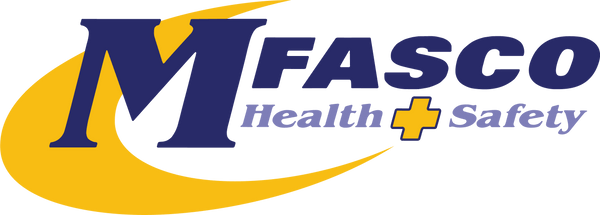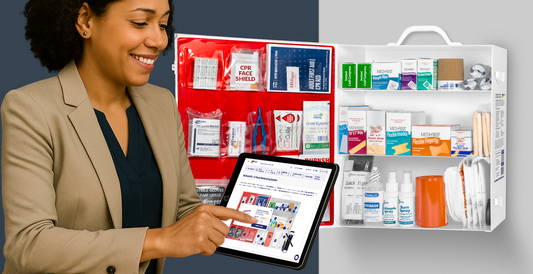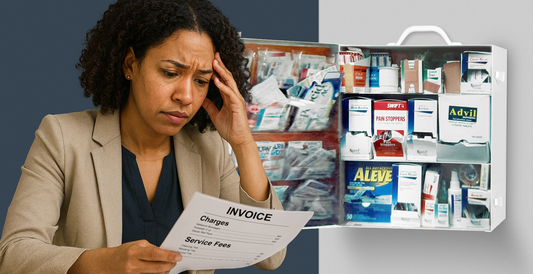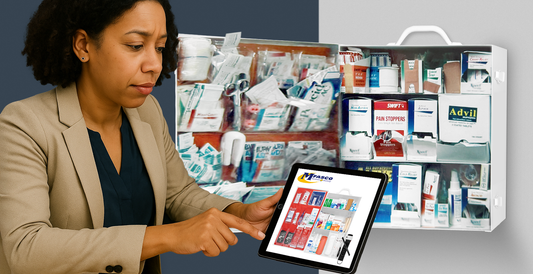OSHA-Approved First Aid Kits for High-Risk Job Sites

In high-risk job environments like construction sites or manufacturing plants, you must have a properly equipped first aid kit on hand. According to OSHA's guidelines, every job site is required to have first aid supplies that are adequate for the number of employees and the hazards of the work being performed. Meeting these standards ensures that workers have immediate access to supplies in case of an emergency, minimizing injury severity and saving lives.
What Makes a First Aid Kit OSHA-Compliant?
OSHA-approved first aid kits must comply with the ANSI Z308.1-2021 standards, which outline the minimum requirements for first aid supplies. For high-risk job sites, Class B kits are recommended because they contain additional and specialized supplies to address more severe injuries likely to occur. For example, a Class B kit will include items like trauma dressings, splints, and a wider range of bandages and antiseptics, which are particularly useful in environments with machinery or heavy equipment.
Why OSHA-Approved Kits Are Essential for High-Risk Job Sites
High-risk job sites in construction, logging, or heavy manufacturing inherently present more dangers than typical workplaces. These environments involve operating heavy machinery, working at great heights, and exposure to electrical hazards or toxic substances. OSHA-approved first aid kits ensure that the specific risks present in these settings are addressed with specialized supplies.
In high-risk environments, injuries can range from severe lacerations, fractures, burns, to chemical exposure, making the presence of adequate first aid supplies a must. For example, Class B first aid kits, which are designed for more dangerous workplaces, contain essential tools such as trauma dressings for heavy bleeding, splints to stabilize fractures, and burn treatment products for injuries caused by electrical fires or chemicals. Having access to these specialized items can prevent further harm before emergency medical services arrive, potentially saving lives.
Traditional OTC Kits vs. ANSI-Approved Kits
Over-the-counter (OTC) first aid kits are typically designed for personal or home use, containing basic items like bandages and antiseptic wipes. While they handle minor injuries, they lack the specialized tools needed for severe injuries common on job sites, such as splints or trauma dressings.
On the other hand, ANSI-approved kits include a wider range of supplies tailored for high-risk environments. These kits are equipped for more serious injuries, meeting OSHA requirements for workplace safety, making them essential for job sites with significant injury risks.
Employers can ensure they have the right supplies for both minor and severe injuries when an ANSI-compliant kit is available, reducing risks and staying compliant with OSHA standards.
Best Kits for High-Risk Job Sites
For high-risk job sites that deal with hazardous conditions, here are a few top options:
- OSHA Compliance First Aid Kit Rugged Case : This Class B kit is durable, waterproof, and designed to handle the rough conditions found on construction sites or in remote locations. It also includes biohazard and bleeding control supplies, which are critical in high-injury-risk environments.
- Construction First Aid Kit OSHA Class A Metal Box : This more compact option meets OSHA’s Class A requirements, making it perfect for smaller teams or vehicles. The metal box is weather-resistant and durable enough for construction sites, ensuring that supplies remain protected from dirt and moisture.
- Osha Class B Kit Waterproof Rugged Case : This is another excellent choice for high-risk sites. Its indestructible plastic case is waterproof, dustproof, and shockproof, providing reliable protection in challenging environments.
Preparing Your Job Site with the Right Kit
Equipping your job site with the right first aid kit is only half of the equation. Employers also need to ensure that the kit is regularly inspected and replenished, and that staff are trained to use the supplies correctly. First aid training should include how to treat common injuries like fractures, burns, and severe bleeding, all of which are risks in high-hazard work environments. The Make Your Own Kit feature allows you to tailor the supplies based on the unique risks of your site, ensuring that your team is prepared for any scenario.
By investing in OSHA-compliant kits and ensuring workers are trained, employers can significantly reduce injury risks and maintain a safer workplace for everyone.
Contributing Expert

Mike Brinker
Mike Brinker has been working in the first aid industry for over 35 years. He has worked with thousands of businesses,groups, and organizations to provide a healthy and safe work environment. Mike helped create “Make-A-Kit”, the internet's only online first aid kit creation tool. He has also authored many helpful first-aid and safety-related resource articles found at the MFASCO Learning Center.




